A Methodology for Identifying Coastal Cultural Heritage Assets Exposed to Future Sea Level Rise Scenarios
Abstract
:1. Introduction
2. Materials and Methods
2.1. Study Area
2.2. Data Collection and Preprocessing
- A vector file depicting the coastline of Mediterranean European countries.
- Digital Elevation Information/Digital Elevation Model.
- Information on vertical ground movement in the area of interest.
- Information on the projections of Sea Level Change for 2050 and 2100 under IPCC scenarios 2.6, 4.5 and 8.5.
2.2.1. Coastline Information
2.2.2. Digital Elevation Models
2.2.3. Vertical Ground Motion Data
- Basic/L2a: This category provides line-of-sight velocity maps—in descending and ascending satellite orbits—including geolocalization and quality measures per point. These products refer to a local reference point.
- Calibrated/L2b: Compared to the basic level of products, the calibrated ones are absolute in value since they do not refer to a local reference point. They include line-of-sight velocity maps referenced to a model derived from GNSS time-series data.
- Ortho/L3: This level of products includes components of motion (horizontal and vertical) anchored to the reference geodetic model. These products follow a raster format of 100 m resolution.
2.2.4. Sea Level Change Projections
2.2.5. Coastal Cultural Heritage
2.3. Methodology Workflow
3. Results
4. Discussion
Author Contributions
Funding
Data Availability Statement
Acknowledgments
Conflicts of Interest
References
- Zanuttigh, B. Coastal flood protection: What perspective in a changing climate? The THESEUS approach. Environ.Sci. Policy 2011, 14, 845–863. [Google Scholar] [CrossRef]
- Pantusa, D.; D’Alessandro, F.; Frega, F.; Francone, A.; Tomasicchio, G.R. Improvement of a coastal vulnerability index and its application along the Calabria Coastline, Italy. Sci. Rep. 2022, 12, 21959. [Google Scholar] [CrossRef] [PubMed]
- Kopp, R.E.; Horton, R.M.; Little, C.M.; Mitrovica, J.X.; Oppenheimer, M.; Rasmussen, D.J.; Strauss, B.H.; Tebaldi, C. Probabilistic 21st and 22nd-century sea-level projections at a global network of tide-gauge sites. Earth’s Future 2014, 2, 383–406. [Google Scholar] [CrossRef]
- Sesana, E.; Gagnon, A.S.; Ciantelli, C.; Cassar, J.; Hughes, J.J. Climate Change Impacts on Cultural Heritage: A Literature Review. WIREs Clim. Chang. 2021, 12, e710. [Google Scholar] [CrossRef]
- Abadie, L.M.; Jackson, L.P.; Sainz de Murieta, E.; Jevrejeva, S.; Galarraga, I. Comparing urban coastal flood risk in 136 cities under two alternative sea-level projections: RCP 8.5 and an expert opinion-based high-end scenario. Ocean Coast. Manag. 2020, 193, 105249. [Google Scholar] [CrossRef]
- Tragaki, A.; Gallousi, C.; Karymbalis, E. Coastal hazard vulnerability assessment based on geomorphic, oceanographic and demographic parameters: The case of Peloponnese (Southern Greece). Land 2018, 7, 56. [Google Scholar] [CrossRef]
- Karymbalis, E.; Chalkias, C.; Chalkias, G.; Grigoropoulou, E.; Manthos, G.; Ferentinou, M. Assessment of the sensitivity of the southern coast of the Gulf of Corinth (Peloponnese, Greece) to sea-level rise. Centr. Eur. J. Geosci. 2012, 4, 561–577. [Google Scholar] [CrossRef]
- Reimann, L.; Vafeidis, A.T.; Brown, S.; Hinkel, J.; Tol, R.S.J. Mediterranean UNESCO World Heritage at risk from coastal flooding and erosion due to sea-level rise. Nat. Commun. 2018, 9, 4161. [Google Scholar] [CrossRef] [PubMed]
- Phillips, H. Adaptation to climate change at UK world heritage sites: Progress and challenges. Hist. Environ. Policy Pract. 2014, 5, 288–299. [Google Scholar] [CrossRef]
- Orbasli, A. Architectural Conservation: Principles and Practice; Blackwell Science: Oxford, UK, 2008. [Google Scholar]
- Bertolin, C. Preservation of Cultural Heritage and Resources Threatened by Climate Change. Geosciences 2019, 9, 250. [Google Scholar] [CrossRef]
- Cassar, M. Climate Change and the Historic Environment. 2005. Available online: https://discovery.ucl.ac.uk/id/eprint/2082/1/2082.pdf (accessed on 5 June 2024).
- Bonazza, A.; Sardella, A. Climate change and cultural heritage: Methods and approaches for damage and risk assessment addressed to a practical application. Heritage 2023, 6, 3578–3589. [Google Scholar] [CrossRef]
- Ravan, M.; Revez, M.J.; Pinto, I.V.; Brum, P.; Birkmann, J. A vulnerability assessment framework for cultural heritage sites: The case of the Roman ruins of Tróia. Int. J. Disaster Risk Sci. 2023, 14, 26–40. [Google Scholar] [CrossRef]
- Valagussa, A.; Frattini, G.; Crosta, G.; Spizzichino, D.; Leoni, G.; Margottini, C. Multi-risk analysis on European Cultural and Natural UNESCO heritage sites. Nat. Hazards 2021, 105, 2659–2676. [Google Scholar] [CrossRef]
- Briz, E.; Garmendia, B.E.; Garmendia, L.; Marcos, I.; Gandini, A. Improving the resilience of historic areas coping with natural and climate change hazards: Interventions based on multi-criteria methodology. Int. J. Archit. Herit. 2023, 18, 1235–1262. [Google Scholar] [CrossRef]
- IPCC. Glossary Working Group II: Impacts, adaptation and vulnerability. Impacts, adaptation and vulnerability. In Contribution of Working Group II to the Fourth Assessment Report of the Intergovernmental Panel on Climate Change; IPCC: Geneva, Switzerland, 2007; Volume 828. [Google Scholar]
- Assessment (MA). Ecosystems and Human Well–being: Current States and Trends. In Findings of the Condition and Trends Working Group in Millennium Ecosystem; Hassan, R., Scholes, R., Ash, N., Eds.; Assessment (MA), Island Press: Washington, DC, USA, 2005; pp. 893–900. [Google Scholar]
- Dassanayake, D.R.; Burzel, A.; Oumeraci, H. Methods for the evaluation of intangible flood losses and their integration in flood risk analysis. Coast. Eng. J. 2018, 57, 1540007-1–1540007-35. [Google Scholar] [CrossRef]
- Sabbioni, C.; Cassar, M.; Brimblecombe, P.; Lefevre, R.A. Vulnerability of Cultural Heritage to Climate Change. 2008. Available online: https://www.coe.int/t/dg4/majorhazards/activites/2009/Ravello15-16may09/Ravello_APCAT2008_44_Sabbioni-Jan09_EN.pdf (accessed on 10 May 2024).
- Mazurczyk, T.; Piekielek, N.; Tansey, E.; Goldman, B. American archives and climate change: Risks and adaptation. Clim. Risk Manag. 2018, 20, 111–125. [Google Scholar] [CrossRef]
- Balica, S.F.; Wright, N.G.; van der Meulen, F. A flood vulnerability index for coastal cities and its use in assessing climate change impacts. Nat. Hazards 2012, 64, 73–105. [Google Scholar] [CrossRef]
- Howard, A.J.; Challis, K.; Holden, J.; Kincey, M.; Passmore, D.G. The impact of climate change on archaeological resources in Britain: A catchment scale assessment. Clim.Chang. 2008, 91, 405–422. [Google Scholar] [CrossRef]
- Camuffo, D.; Bertolin, C.; Schenal, P. Climate change, sea level rise and impact on monuments in Venice. In Second International Congress on Science and Technology for the Conservation of Cultural Heritage; Rogerio-Candelera, M.A., Ed.; CRC Press: Boca Raton, FL, USA, 2014. [Google Scholar]
- Marzeion, B.; Levermann, A. Loss of cultural world heritage and currently inhabited places to sea-level rise. Environ. Res. Lett. 2014, 9, 034001. [Google Scholar] [CrossRef]
- Ravanelli, R.; Riguzzi, F.; Anzidei, M.; Vecchio, A.; Nigro, L.; Spagnoli, F.; Crespi, M. Sea level rise scenario for 2100 A.D. for the archaeological site of Motya. Rend. Lincei. Sci. Fis. Nat. 2019, 30, 747–757. [Google Scholar] [CrossRef]
- Henriques, R.J.; de Oliveira, F.S.; Schaefer, C.E.G.R.; Lopes, P.R.C.; Senra, E.O.; Lourenço, V.R.; Francelino, M.R. Impacts of anthropocene sea-level rise on people, environments, and archaeological sites in Marajó Island, Brazilian Amazonia. J. S. Am. Earth. Sci. 2024, 136, 104836. [Google Scholar] [CrossRef]
- Sánchez, F.G.; Sánchez, H.G.; Ribalaygua, C. Cultural heritage and sea level rise threat: Risk assessment of coastal fortifications in the Canary Islands. J. Cult. Herit. 2020, 44, 211–217. [Google Scholar] [CrossRef]
- Anzidei, M.; Doumaz, F.; Vecchio, A.; Serpelloni, E.; Pizzimenti, L.; Civico, R.; Greco, M.; Martino, G.; Enei, F. Sea Level Rise Scenario for 2100 A.D. in the Heritage Site of Pyrgi (Santa Severa, Italy). J. Mar. Sci. Eng. 2020, 8, 64. [Google Scholar] [CrossRef]
- Church, J.A.; Clark, P.U.; Cazenave, A.; Gregory, J.M.; Jevrejeva, S.; Levermann, A.; Merrifield, M.A.; Milne, G.A.; Nerem, R.S.; Nunn, P.D.; et al. Sea level change. In Climate Change 2013: The Physical Science Basis. Contribution of Working Group I to the Fifth Assessment Report of the Intergovernmental Panel on Climate Change; Stocker, T.F., Qin, T.F., Plattner, G.K., Tignor, M., Allen, S.K., Boschung, J., Nauels, A., Xia, Y., Bex, V., Midgley, P.M., Eds.; Cambridge University Press: Cambridge, UK, 2013; pp. 1137–1216. [Google Scholar]
- Meinshausen, M.; Smith, S.J.; Calvin, K.; Daniel, J.S.; Kainuma, M.L.T.; Lamarque, J.F.; Matsumoto, K.; Montzka, S.A.; Raper, S.C.B.; Riahi, K.; et al. The RCP greenhouse gas concentrations and their extensions from 1765 to 2300. Clim. Chang. 2011, 109, 213–241. [Google Scholar] [CrossRef]
- Moss, R.H.; Edmonds, J.A.; Hibbard, K.A.; Manning, M.R.; Rose, S.K.; van Vuuren, D.P.; Carter, T.R.; Emori, S.; Kainuma, M.; Kram, T.; et al. The next generation of scenarios for climate change research and assessment. Nature 2010, 463, 747–756. [Google Scholar] [CrossRef]
- IPCC. Climate Change 2014: Synthesis Report. Contribution of Working Groups I, II and III to the Fifth Assessment Report of the Intergovernmental Panel on Climate Change; Core Writing Team, Pachauri, R.K., Meyer, L.A., Eds.; IPCC: Geneva, Switzerland, 2014; Volume 151. [Google Scholar]
- Reisinger, A.; Howden, M.; Vera, C.; Garschagen, M.; Hurlbert, M.; Kreibiehl, S.; Mach, K.J.; Mintenbeck, K.; O’Neill, B.; Pathak, M.; et al. The Concept of Risk in the IPCC Sixth Assessment Report: A Summary of Cross-Working Group Discussions; Intergovernmental Panel on Climate Change: Geneva, Switzerland, 2020; Volume 15, Available online: https://www.ipcc.ch/site/assets/uploads/2021/02/Risk-guidance-FINAL_15Feb2021.pdf (accessed on 10 June 2024).
- Slangen, A.B.A.; Carson, M.; Katsman, C.A.; van de Wal, R.S.W.; Köhl, A.; Vermeersen, L.L.A.; Stammer, D. Projecting twenty-first century regional sea-level changes. Clim. Chang. 2014, 124, 317–332. [Google Scholar] [CrossRef]
- Rovere, A.; Raymo, M.E.; Vacchi, M.; Lorscheid, T.; Stocchi, P.; Gómez-Pujol, L.; Harris, D.L.; Casella, E.; O’Leary, M.J.; Hearty, P.J. The analysis of Last Interglacial (MIS 5e) relative sea-level indicators: Reconstructing sea-level in a warmer world. Earth Sci. Rev. 2016, 159, 404–427. [Google Scholar] [CrossRef]
- Wada, Y.; van Beek, L.P.H.; Sperna Weiland, F.C.; Chao, B.F.; Wu, Y.H.; Bierkens, M.F.P. Past and future contribution of global groundwater depletion to sea-level rise. Geophys. Res. Lett. 2012, 39, L09402. [Google Scholar] [CrossRef]
- Stammer, D.; Cazenave, A.; Ponte, R.M.; Tamisiea, M.E. Causes for contemporary regional sea level changes. Ann. Rev. Mar. Sci. 2013, 5, 21–46. [Google Scholar] [CrossRef] [PubMed]
- Church, J.A.; White, N.J. A 20th century acceleration in global sea-level rise. Geophys. Res. Lett. 2006, 33, L01602. [Google Scholar] [CrossRef]
- Hay, C.C.; Morrow, E.; Kopp, R.E.; Mitrovica, J.X. Probabilistic reanalysis of twentieth-century sea-level rise. Nature 2015, 517, 481–484. [Google Scholar] [CrossRef]
- Oppenheimer, M.; Glavovic, B.C.; Hinkel, J.; Van de Wal, R.; Magnan, A.K.; Abd-Elgawad, A.; Cai, R.; Cifuentes-Jara, M.; DeConto, R.M.; Ghosh, T.; et al. Sea Level Rise and Implications for Low-Lying Islands, Coasts and Communities. In IPCC Special Report on the Ocean and Cryosphere in a Changing Climate; Pörtner, H.O., Roberts, D.C., Masson-Delmotte, V., Zhai, P., Tignor, M., Poloczanska, E., Mintenbeck, K., Alegría, A., Nicolai, M., Okem, A., et al., Eds.; Cambridge University Press: Cambridge, UK; New York, NY, USA, 2019; Available online: https://www.ipcc.ch/site/assets/uploads/sites/3/2022/03/06_SROCC_Ch04_FINAL.pdf (accessed on 3 June 2024).
- Bamber, J.L.; Oppenheimer, M.; Kopp, R.E.; Aspinall, W.P.; Cooke, R.M. Ice sheet contributions to future sea-level rise from structured expert judgment. Proc. Natl. Acad. Sci. USA 2019, 116, 11195–11200. [Google Scholar] [CrossRef]
- TRIQUETRA Project: Toolbox for Assessing and Mitigating Climate Change Risks and Natural Hazards Threatening Cultural Heritage. Available online: https://triquetra-project.eu/ (accessed on 25 May 2024).
- Ioannidis, C.; Verykokou, S.; Soile, S.; Istrati, D.; Spyrakos, C.; Sarris, A.; Akritidis, D.; Feidas, H.; Georgoulias, A.K.; Tringa, E.; et al. Safeguarding Our Heritage—The TRIQUETRA Project Approach. Heritage 2024, 7, 758–793. [Google Scholar] [CrossRef]
- Wessel, P.; Smith, W.H.F. A Global Self-Consistent, Hierarchical, High-resolution Shoreline Database. J. Geophys. Res. 1996, 101, 8741–8743. [Google Scholar] [CrossRef]
- Sayre, R.; Noble, S.; Hamann, S.; Smith, R.; Wright, D.; Breyer, S.; Butler, K.; Van Graafeiland, K.; Frye, C.; Karagulle, D.; et al. A new 30-meter resolution global shoreline vector and associated global islands database for the development of standardized ecological coastal units. J. Oper. Oceanogr. 2019, 12 (Suppl. S2), 47–56. [Google Scholar] [CrossRef]
- EEA Coastline for Analysis. Available online: https://www.eea.europa.eu/en/datahub/datahubitem-view/af40333f-9e94-4926-a4f0-0a787f1d2b8f (accessed on 10 June 2024).
- Emmendorfer, I.B.; de Almeida, L.P.M.; Alves, D.C.L.; Emmendorfer, L.R.; Arigony-Neto, J. Accuracy assessment of global DEMs for the mapping of coastal flooding on a low-lying sandy environment: Cassino Beach, Brazil. Reg. Stud. Mar. Sci. 2024, 74, 103535. [Google Scholar] [CrossRef]
- Sánchez-García, E.A.; Yañez-Arenas, C.; Lindig-Cisneros, R.; Lira-Noriega, A.; Ibarra, R.M.; Moreno-Casasola, P. The expected impacts of sea level on the Mexican Atlantic coast. Sci. Total Environ. 2023, 903, 166317. [Google Scholar] [CrossRef]
- Distefano, S.; Gamberi, F. Preservation of Transgressive System Tract Geomorphic Elements during the Holocene Sea Level Rise in the South-Eastern Sicilian Tyrrhenian Margin. J. Mar. Sci. Eng. 2022, 10, 1013. [Google Scholar] [CrossRef]
- Fandé, M.B.; Ponte Lira, C.; Penha-Lopes, G. Using TanDEM-X Global DEM to Map Coastal Flooding Exposure under Sea-Level Rise: Application to Guinea-Bissau. ISPRS Int. J. Geo-Inf. 2022, 11, 225. [Google Scholar] [CrossRef]
- Abrams, M.; Yamaguchi, Y.; Crippen, R. Aster Global Dem (GDEM) Version 3. Int. Arch. Photogramm. Remote Sens. Spat. Inf. Sci. 2022, 43, 593–598. [Google Scholar] [CrossRef]
- Gesch, D.; Oimoen, M.; Danielson, J.; Meyer, D. Validation of the ASTER global digital elevation model version 3 over the conterminous Unites States. Int. Arch. Photogramm. Remote Sens. Spat. Inf. Sci. 2016, 41, 143–148. [Google Scholar] [CrossRef]
- Crippen, R.; Buckley, S.; Agram, P.; Belz, E.; Gurrola, E.; Hensley, S.; Kobrick, M.; Lavalle, M.; Martin, J.; Neumann, M.; et al. Nasadem Global Elevation Model: Methods and Progress. Int. Arch. Photogramm. Remote Sens. Spat. Inf. Sci. 2016, 41, 125–128. [Google Scholar] [CrossRef]
- Abrams, M.; Crippen, R.; Fujisada, H. ASTER Global Digital Elevation Model (GDEM) and ASTER Global Water Body Dataset (ASTWBD). Remote Sens. 2020, 12, 1156. [Google Scholar] [CrossRef]
- Buckley, S.M.; Agram, P.S.; Belz, J.E.; Crippen, R.E.; Gurrola, E.M.; Hensley, S.; Kobrick, M.; Lavalle, M.; Martin, J.M.; Neumann, M.; et al. NASADEM: UserGuide, NASA/Jpl. 2020, 48. Available online: https://lpdaac.usgs.gov/documents/592/NASADEM_User_Guide_V1.pdf (accessed on 5 May 2024).
- Tadono, T.; Nagai, H.; Ishida, H.; Oda, F.; Naito, S.; Minakawa, K.; Iwamoto, H. Generation of the 30 m-mesh global digital surface model by ALOS PRISM. Int. Arch. Photogramm. Remote Sens. Spat. Inf. Sci. 2016, 41, 157–162. [Google Scholar] [CrossRef]
- Farr, T.G.; Rosen, P.A.; Caro, E.; Crippen, R.; Duren, R.; Hensley, S.; Kobrick, M.; Paller, M.; Rodriquez, E.; Roth, L.; et al. The shuttle radar topography mission. Rev. Geophys. 2007, 45, 1–33. [Google Scholar] [CrossRef]
- Rodriguez, E.; Morris, C.S.; Belz, J.E. A global assessment of the SRTM performance. Photogramm. Eng. Remote Sens. 2006, 72, 249–260. [Google Scholar] [CrossRef]
- Wessel, B.; Huber, M.; Wohlfart, C.; Marschalk, U.; Kosmann, D.; Roth, A. Accuracy Assessment of the global TanDEM-X Digital Elevation Model with GPS Data. ISPRS J. Photogramm. 2018, 139, 171–182. [Google Scholar] [CrossRef]
- Ghannadi, M.A.; Alebooye, S.; Izadi, M.; Ghanadi, A. Vertical accuracy assessment of Copernicus DEM (case study: Tehran and Jam cities). ISPRS Ann. Photogramm. Remote Sens. Spat. Inf. Sci. 2023, 10, 209–214. [Google Scholar] [CrossRef]
- Krdžalić, D.; Ćatić, J.; Vrce, E.; Omićević, D. Evaluating the accuracy of the digital models (DEMs) within the Territory of Bosnia and Herzegovina. Remote Sens. Appl. Soc. Environ. 2024, 34, 101187. [Google Scholar] [CrossRef]
- Hu, Z.; Peng, J.; Hou, Y.; Shan, J. Evaluation of recently released open global digital elevation models of Hubei, China. Remote Sens. 2017, 9, 262. [Google Scholar] [CrossRef]
- Dong, Y.; Chang, H.C.; Chen, W.; Zhang, K.; Feng, R. Accuracy assessment of GDEM, SRTM, and DLR-SRTM in Northeastern China. Geocarto Int. 2015, 30, 779–792. [Google Scholar] [CrossRef]
- Purinton, B.; Bookhagen, B. Validation of digital elevation models (DEMs) and comparison of geomorphic metrics on the southern Central Andean Plateau. Earth Surf. Dyn. 2017, 5, 211–237. [Google Scholar] [CrossRef]
- Varga, M.; Bašić, T. Accuracy validation and comparison of global digital elevation models over Croatia. Int. J. Remote Sens. 2015, 36, 170–189. [Google Scholar] [CrossRef]
- Moudrý, V.; Lecours, V.; Gdulová, K.; Gábor, L.; Moudrá, L.; Kropáček, J.; Wild, J. On the use of global DEMs in ecological modelling and the accuracy of new bare-earth DEMs. Ecol. Modell. 2018, 383, 3–9. [Google Scholar] [CrossRef]
- Bolkas, D.; Fotopoulos, G.; Braun, A.; Tziavos, I.N. Assessing digital elevation model uncertainty using GPS survey data. J. Surv. Eng. 2016, 142, 04016001. [Google Scholar] [CrossRef]
- Carrera-Hernandez, J.J. Not all DEMs are equal: An evaluation of six globally available 30m resolution DEMs with geodetic benchmarks and LiDAR in Mexico. Remote Sens. Environ. 2021, 261, 112474. [Google Scholar] [CrossRef]
- Uuemaa, E.; Ahi, S.; Montibeller, B.; Muru, M.; Kmoch, A. Vertical Accuracy of Freely Available Global Digital Elevation Models (ASTER, AW3D30, MERIT, TanDEM-X, SRTM, NASADEM). Remote Sens. 2020, 12, 3482. [Google Scholar] [CrossRef]
- Constantini, M.; Minati, F.; Trillo, F.; Ferretti, A.; Novali, F.; Passera, E.; Dehls, J.; Larsen, Y.; Marinkovic, P.; Eineder, M.; et al. European Ground Motion Service. In Proceedings of the 2021 IEEE International Geoscience and Remote Sensing Symposium IGARSS, Brussels, Belgium, 11–16 July 2021; Institute of Electrical and Electronics Engineers (IEEE): Piscataway, NJ, USA, 2021; pp. 3293–3296. [Google Scholar] [CrossRef]
- Crosetto, M.; Solari, L.; Mróz, M.; Balasis-Levinsen, J.; Casagli, N.; Frei, M.; Oyen, A.; Moldestad, D.A.; Bateson, L.; Guerrieri, L.; et al. The Evolution of Wide-Area DInSAR: From Regional and National Services to the European Ground Motion Service. Remote Sens. 2020, 12, 2043. [Google Scholar] [CrossRef]
- Crosetto, M.; Solari, L.; Balasis-Levinsen, J.; Casagli, N.; Frei, M.; Oyen, A.; Molestad, D.A. Ground Deformation monitoring at continental scale: The european ground motion service. Int. Arch. Photogramm. Remote Sens. Spat. Inf. Sc. 2020, 43, 293–298. [Google Scholar] [CrossRef]
- Barra, A.; Reyes-Carmona, C.; Herrera, G.; Galve, J.P.; Solari, L.; Mateos, R.M.; Azañón, J.M.; Béjar-Pizarro, M.; López-Vinielles, J.; Palamà, R.; et al. From satellite interferometry displacements to potential damage maps: A tool for risk reduction and urban planning. Remote Sens. Environ. 2022, 282, 113294. [Google Scholar] [CrossRef]
- Crosetto, M.; Solari, L.; Balasis-Levinsen, J.; Bateson, L.; Casagli, N.; Frei, M.; Oyen, A.; Molestad, D.A.; Mróz, M. Deformation monitoring at european scale: The copernicus ground motion service. Int. Arch. Photogramm. Remote Sens. Spat. Inf. Sc. 2021, 43, 141–146. [Google Scholar] [CrossRef]
- Sala Calero, J.; Vöge, M.; Esteves Martins, J.; Raucoules, D.; de Michelle, M.; Vradi, A.; Vecchiotti, F. Validation Report-Services Supporting the European Environment Agency’s (EEA) Implementation of the Copernicus European Ground Motion Service-Product Validation v.2.0. Available online: https://land.copernicus.eu/en/technical-library/validation-report-2015-2021-dataset/@@download/file (accessed on 15 June 2024).
- IPCC. Climate Change 2021: The Physical Science Basis. Contribution of Working Group I to the Sixth Assessment Report of the Intergovernmental Panel on Climate Change; Masson-Delmotte, V., Zhai, P., Pirani, A., Connors, S.L., Péan, C., Berger, S., Caud, N., Chen, Y., Goldfarb, L., Gomis, M.I., et al., Eds.; Cambridge University Press: Cambridge, UK; New York, NY, USA, 2021; Volume 2391, in press. [Google Scholar] [CrossRef]
- Kopp, R.E.; Garner, G.G.; Hermans, T.H.J.; Jha, S.; Kumar, P.; Reedy, A.; Slangen, A.B.A.; Turilli, M.; Edwards, T.L.; Gregory, J.M.; et al. The Framework for Assessing Changes To Sea-level (FACTS) v1.0: A platform for characterizing parametric and structural uncertainty in future global, relative, and extreme sea-level change. Geosci. Model Dev. 2023, 16, 7461–7489. [Google Scholar] [CrossRef]
- Crosetto, M.; Solari, L. Chapter 3—InSAR technical aspects. In Satellite Interferometry Data Interpretation and Exploitation; Crosetto, M., Solari, L., Eds.; Elsevier: Amsterdam, The Netherlands, 2023; pp. 27–62. [Google Scholar] [CrossRef]
- Chiarabba, C.; De Gori, P.; Mele, F.M. Recent seismicity of Italy: Active tectonics of the central Mediterranean region and seismicity rate changes after the Mw 6.3 L’Aquila earthquake. Tectonophysics 2015, 638, 82–93. [Google Scholar] [CrossRef]
- Yolsal-Çevikbilen, S.; Taymaz, T. Earthquake source parameters along the Hellenic subduction zone and numerical simulations of historical tsunamis in the Eastern Mediterranean. Tectonophysics 2012, 536, 61–100. [Google Scholar] [CrossRef]
- Panzera, E.; de Graaff, T.; de Groot, H.L.F. European cultural heritage and tourism flows: The magnetic role of superstar World Heritage Sites. Pap. Reg. Sci. 2021, 100, 101–123. [Google Scholar] [CrossRef]
- García-Hernández, M.; De la Calle-Vaquero, M.; Yubero, C. Cultural Heritage and Urban Tourism: Historic City Centres under Pressure. Sustainability 2017, 9, 1346. [Google Scholar] [CrossRef]
- Richards, G.W. Tourism and Culture Synergies; UNWTO: Madrid, Spain, 2018; 160 p. [Google Scholar]
- Scott, D.; Lemieux, C. Weather and Climate Information for Tourism. Procedia Environ. Sci. 2010, 1, 146–183. [Google Scholar] [CrossRef]
- Ferranin, C.; Lionello, P.; Orlić, M.; Raicich, F.; Salvadori, G. Venice as a paradigm of coastal flooding under multiple compound drivers. Sci. Rep. 2022, 12, 5754. [Google Scholar] [CrossRef]
- Leonardi, N. The barriers of Venice. Nat. Geosci. 2021, 14, 881–882. [Google Scholar] [CrossRef]
- Mel, R.; Carniello, L.; D’Alpaos, L. Addressing the effect of the Mo.S.E barriers closure on wind setup within the Venice Lagoon. Estuar. Coast. Shelf Sci. 2019, 225, 106249. [Google Scholar] [CrossRef]
- Mel, R.A.; Viero, D.P.; Carniello, L.; Defina, A.; D’ Alpaos, L. The first operations of the Mo.S.E system to prevent the flooding of Venice: Insights on the hydrodynamics of a regulated lagoon. Estuar. Coast. Shelf Sci. 2021, 261, 107547. [Google Scholar] [CrossRef]
- Giupponi, C.; Bidoia, M.; Breil, M.; Di Corato, L.; Gain, A.K.; Leoni, V.; Fard, B.M.; Pesenti, R.; Umgiesser, G. Boon and burden: Economic performance and future perspectives of the Venice flood protection system. Reg. Environ. Chang. 2024, 24, 44. [Google Scholar] [CrossRef]
- Vergano, L.; Umgiesser, G.; Nunes, P.A.L.D. An economic assessment of the impacts of the MOSE barriers on Venice port activities. Transp. Res. Part D Transp. Environ. 2010, 15, 343–349. [Google Scholar] [CrossRef]
- Tognin, D.; D’Alpaos, A.; Marani, M.; Carnielo, L. Marsh Resilience to sea-level rise reduced by storm-surge barriers in the Venice Lagoon. Nat. Geosci. 2021, 14, 906–911. [Google Scholar] [CrossRef]
- Dawson, T. Taking the middle path to the coast: How community collaboration can help save threatened sites. In The Future of Heritage as Climates Change: Loss, Adaptation and Creativity; Harvey, D., Perry, J., Eds.; Routledge: London, UK, 2015; pp. 248–267. [Google Scholar]
- Graham, E.; Hambly, J.; Dawson, T. Learning from Loss: Eroding Coastal Heritage in Scotland. Humanities 2017, 6, 87. [Google Scholar] [CrossRef]
- Fatoric, S.; Seekamp, E. Are cultural heritage and resources threatened by climate change? A systematic literature review. Clim. Chang. 2017, 142, 227–254. [Google Scholar] [CrossRef]
- Forino, G.; MacKee, J.; von Meding, J. A proposed assessment index for climate-related risk for cultural heritage protection in Newcastle (Australia). Int. J. Disaster Risk Red. 2016, 19, 235–248. [Google Scholar] [CrossRef]
- Giglio, F.; Frontera, P.; Malara, A.; Armocida, F. Materials and Climate Change: A Set of Indices as the Benchmark for Climate Vulnerability and Risk Assessment for Tangible Cultural Heritage in Europe. Sustainability 2024, 16, 2067. [Google Scholar] [CrossRef]
- Trček, D. Cultural heritage preservation by using blockchain technologies. Herit. Sci. 2022, 10, 6. [Google Scholar] [CrossRef]
- Colace, F.; Elia, C.; Guida, C.G.; Lorusso, A.; Marongiu, F.; Santaniello, D. An IoT-based Framework to Protect Cultural Heritage Buildings. In Proceedings of the IEEE International Conference on Smart Computing (SMARTCOMP), Irvine, CA, USA, 23–27 August 2021; pp. 377–382. [Google Scholar] [CrossRef]
- Casillo, M.; Colace, F.; Gaeta, R.; Lorusso, A.; Santaniello, D.; Valentino, C. Revolutionizing cultural heritage preservation: An innovative IoT-based framework for protecting historical buildings. Evol. Intell. 2024. [CrossRef]
- Sampaio, A.Z.; Gomes, A.M.; Sánchez-Lite, A.; Zulueta, P.; González-Gaya, C. Analysis of BIM Methodology Applied to Practical Cases in the Preservation of Heritage Buildings. Sustainability 2021, 13, 3129. [Google Scholar] [CrossRef]
- Castellazzi, G.; Cardillo, E.; Lo Presti, N.; D’Altri, A.M.; de Miranda, S.; Bertani, G.; Ferretti, F.; Mazzotti, C. Advancing Cultural Heritage Structures Conservation: Integrating BIM and Cloud-Based Solutions for Enhanced Management and Visualization. Heritage 2023, 6, 7316–7342. [Google Scholar] [CrossRef]
- Sestras, P.; Ros, S.; Bilas, S.; Nas, S.; Buru, S.M.; Kovacs, L.; Spalevic, V.; Sestras, A.F. Feasibility assessments using unmanned aerial vehicle technology in heritage buildings: Rehabilitation-restoration, spatial analysis and tourism potential analysis. Sensors 2020, 20, 2054. [Google Scholar] [CrossRef] [PubMed]
- Moise, C.; Lazar, A.-M.; Mihalache, C.E.; Dedulescu, L.A.; Negula, I.F.D.; Badea, A.; Poenaru, V.D.; Moise, R.; Ortan, A.R. Geomatics Technologies in the Framework of Multidisciplinary Project for Integrated Management of Cultural Heritage Sites. Int. Arch. Photogramm. Remote Sens. Spat. Inf. Sci. 2020, 43, 1477–1484. [Google Scholar] [CrossRef]
- Antón, D.; Pineda, P.; Medjdoub, B.; Iranzo, A. As-built 3D heritage city modelling to support numerical structural analysis: Application to the assessment of an archaeological remain. Remote Sens. 2019, 11, 1276. [Google Scholar] [CrossRef]
- Kolokoussis, P.; Skamantzari, M.; Tapinaki, S.; Karathanassi, S.; Georgopoulos, A. 3D and hyperspectral data integration for assessing material degradation in medieval masonry heritage buildings. Int. Arch. Photogramm. Remote Sens. Spat. Inf. Sci. 2021, 43, 583–590. [Google Scholar] [CrossRef]
- Greco, E.; Gaetano, A.S.; De Spirt, A.; Semeraro, S.; Piscitelli, P.; Miani, A.; Mecca, S.; Karaj, S.; Trombin, R.; Hodgton, R.; et al. AI-Enhanced Tools and Strategies for Airborne Disease Prevention in Cultural Heritage Sites. Epidemiologia 2024, 5, 267–274. [Google Scholar] [CrossRef]



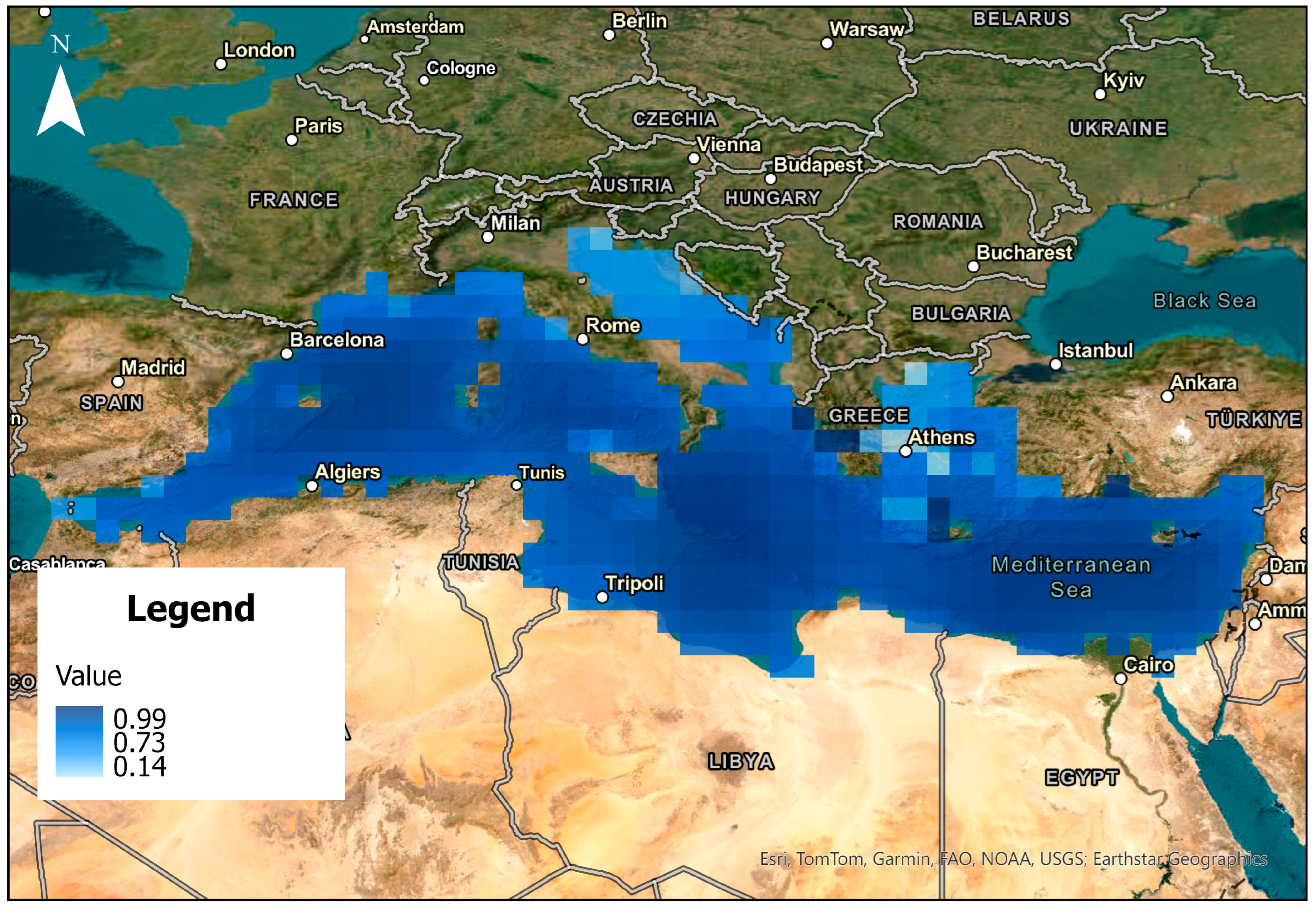
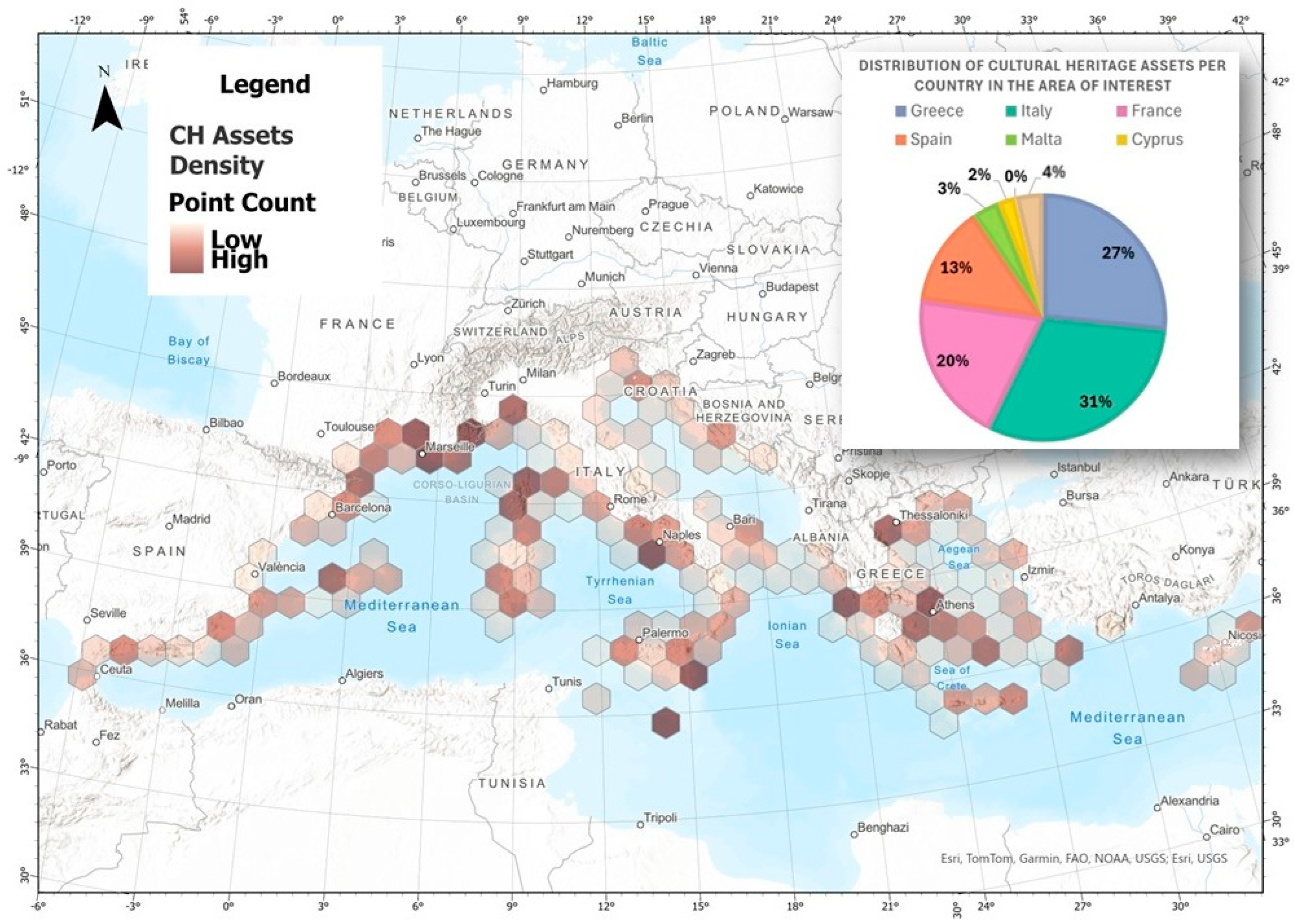
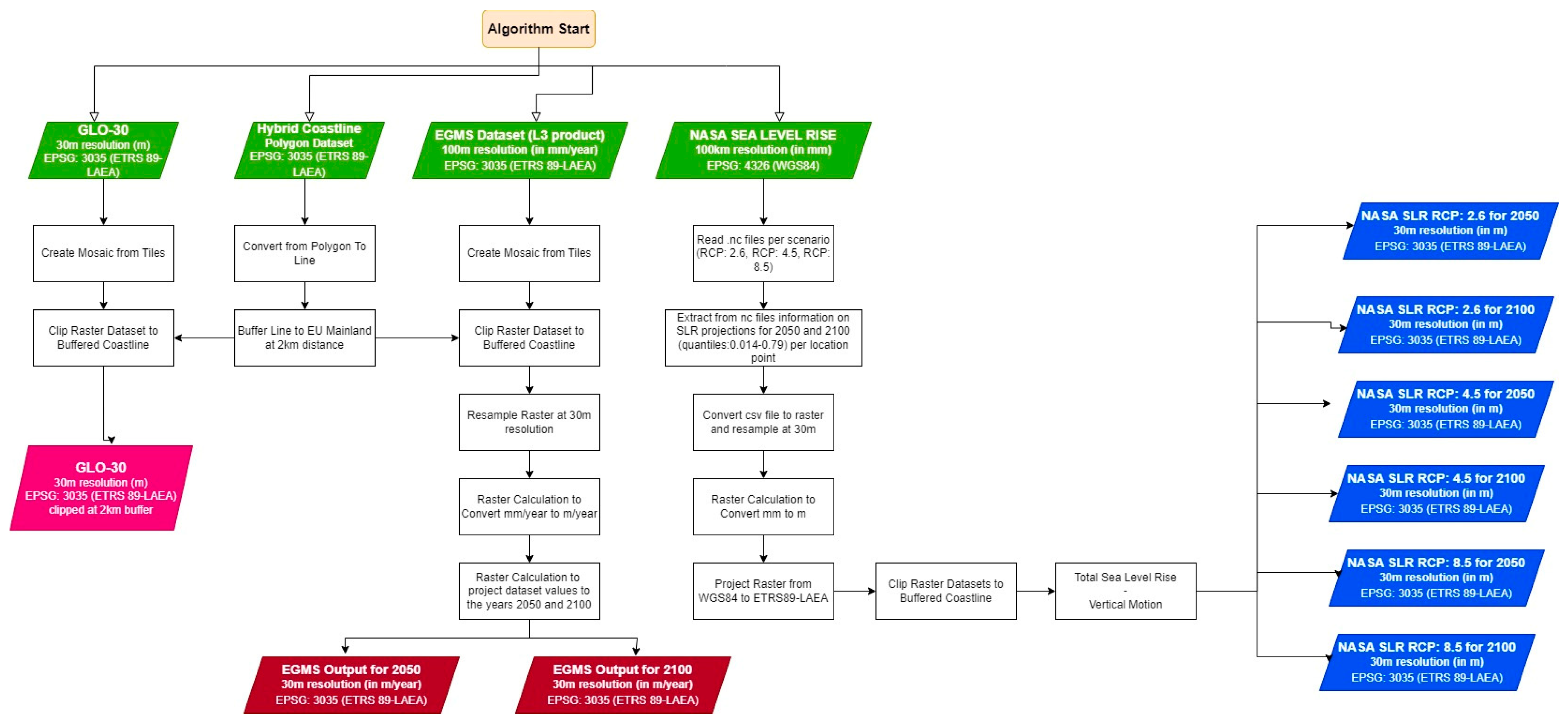

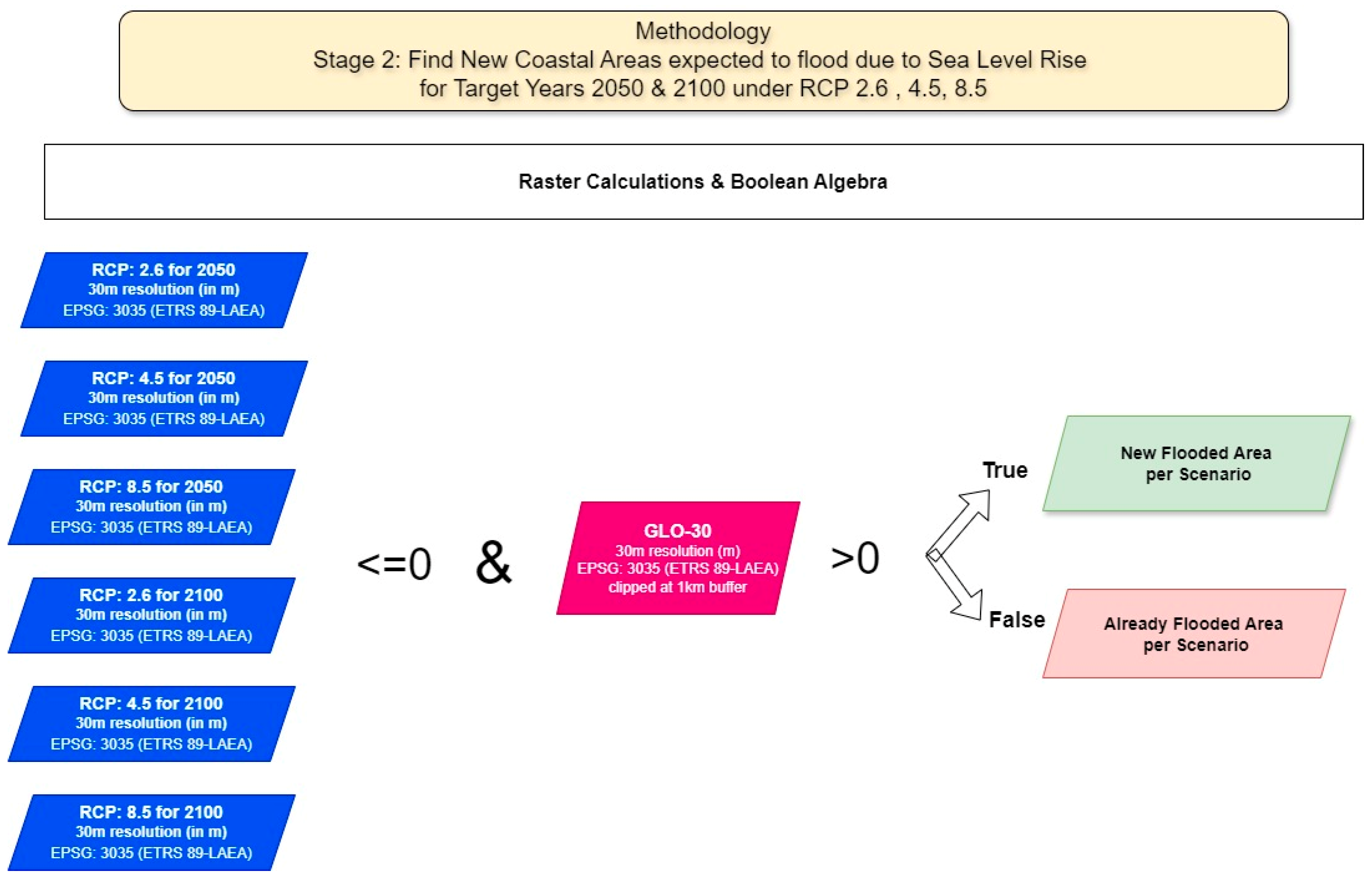
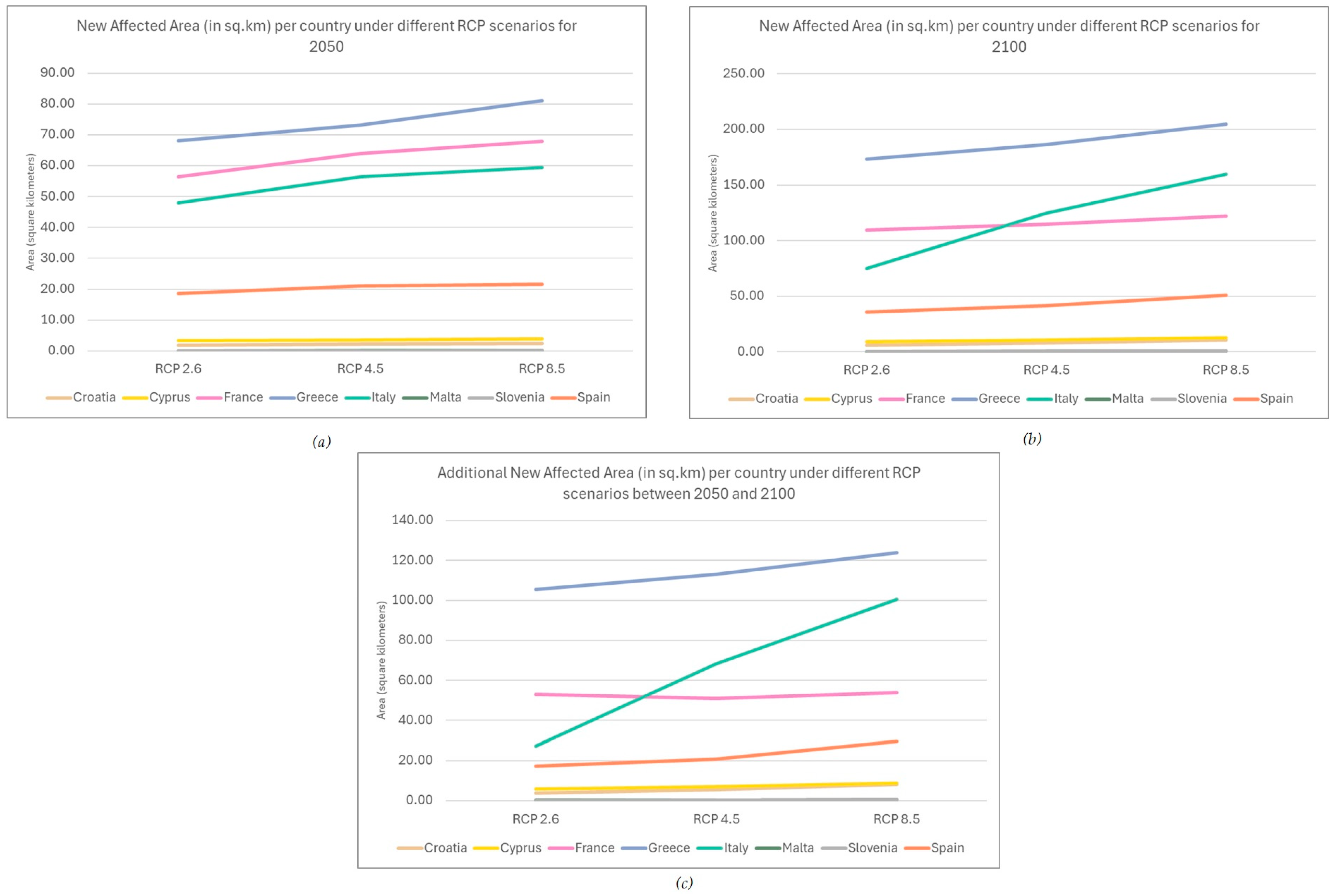

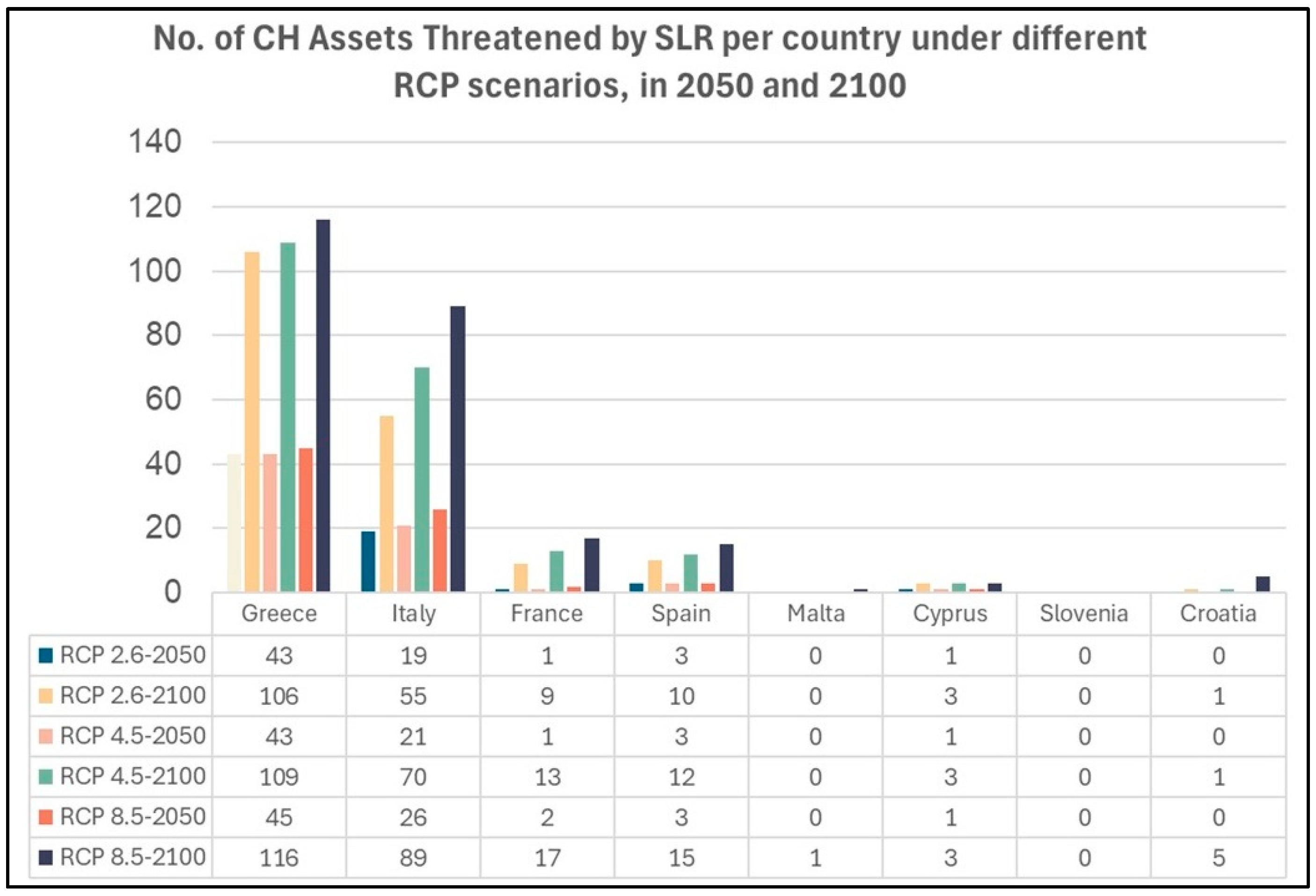
| Country | Coastline (km) |
|---|---|
| Greece | 17,277.92 |
| Italy | 14,673.59 |
| Spain | 6835.66 |
| Croatia | 5798.06 |
| France | 5559.29 |
| Cyprus | 737.39 |
| Malta | 255.63 |
| Slovenia | 55.57 |
| 2050 | 2100 | |||||
|---|---|---|---|---|---|---|
| RCP 2.6 | RCP 4.5 | RCP 8.5 | RCP 26 | RCP 4.5 | RCP 8.5 | |
| Croatia | 1.91 | 2.21 | 2.47 | 5.73 | 7.82 | 10.68 |
| Cyprus | 3.40 | 3.59 | 3.88 | 9.20 | 10.53 | 12.69 |
| France | 56.49 | 63.91 | 68 | 109.47 | 114.82 | 121.84 |
| Greece | 68.10 | 73.11 | 81.02 | 173.53 | 186.26 | 204.83 |
| Italy | 48.00 | 56.41 | 59.42 | 75.20 | 124.54 | 159.92 |
| Malta | 0.07 | 0.08 | 0.08 | 0.28 | 0.39 | 0.55 |
| Slovenia | 0.19 | 0.19 | 0.20 | 0.30 | 0.54 | 0.70 |
| Spain | 18.64 | 21.04 | 21.52 | 36.01 | 41.75 | 51.15 |
| Total: | 196.81 | 220.55 | 236.60 | 409.73 | 486.66 | 562.37 |
| Location | Mean Velocity (mm/Year) | Mean Velocity (St.D) |
|---|---|---|
| Rhodes (GR) | −1.46 | 0.31 |
| Santorini (GR) | 1.14 | 0.24 |
| Samos (GR) | 12.84 | 1.62 |
| Delos (GR) | −0.28 | 0.17 |
| Napoli (IT) | −1.75 | 0.28 |
| Sicily (IT) | −1.08 | 0.38 |
| Mallorca (ES) | −1.35 | 0.05 |
| Barcelona (ES) | −1.45 | 0.01 |
| Marseille (FR) | −1.26 | 0.01 |
| Nice (FR) | −0.91 | 0.02 |
| Dubrovnik (CR) | −2.44 | 0.22 |
| Hvar (CR) | −1.01 | 0.21 |
| Paphos (CY) | −1.37 | 0.21 |
| Malta (MLT) | −1.91 | 0.25 |
Disclaimer/Publisher’s Note: The statements, opinions and data contained in all publications are solely those of the individual author(s) and contributor(s) and not of MDPI and/or the editor(s). MDPI and/or the editor(s) disclaim responsibility for any injury to people or property resulting from any ideas, methods, instructions or products referred to in the content. |
© 2024 by the authors. Licensee MDPI, Basel, Switzerland. This article is an open access article distributed under the terms and conditions of the Creative Commons Attribution (CC BY) license (https://creativecommons.org/licenses/by/4.0/).
Share and Cite
Chalkidou, S.; Georgiadis, C.; Roustanis, T.; Patias, P. A Methodology for Identifying Coastal Cultural Heritage Assets Exposed to Future Sea Level Rise Scenarios. Appl. Sci. 2024, 14, 7210. https://doi.org/10.3390/app14167210
Chalkidou S, Georgiadis C, Roustanis T, Patias P. A Methodology for Identifying Coastal Cultural Heritage Assets Exposed to Future Sea Level Rise Scenarios. Applied Sciences. 2024; 14(16):7210. https://doi.org/10.3390/app14167210
Chicago/Turabian StyleChalkidou, Sevasti, Charalampos Georgiadis, Themistoklis Roustanis, and Petros Patias. 2024. "A Methodology for Identifying Coastal Cultural Heritage Assets Exposed to Future Sea Level Rise Scenarios" Applied Sciences 14, no. 16: 7210. https://doi.org/10.3390/app14167210






